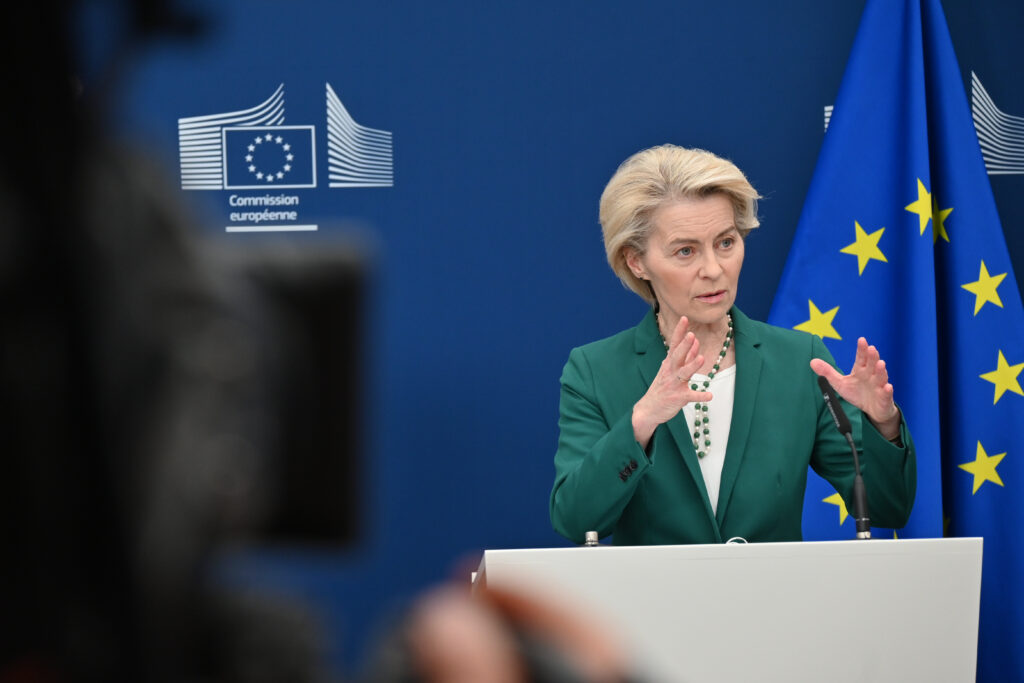
In 2016, Europeans were taken by surprise when US President Donald Trump was elected and began challenging long-held assumptions about globalization and free trade. Consequently, the European Union (EU) was only able to respond to US tariffs in an ad-hoc manner. This time around, however, Brussels has prepared itself for a more contentious global economic order, developing an economic-security toolbox designed to deter third counties from “coercing” the continent. While the tools were mainly formed with China’s unfair trading practices in mind, the EU is now considering whether to use them in response to the Trump administration’s declaration of “economic independence” and its latest round of “liberation day” tariffs.
As part of the EU’s “open strategic autonomy” strategy, the strongest card that the bloc has in its hand is the “anti-coercion instrument.” Confronted with Washington’s array of tariffs across three fronts—25 percent on automotive and car parts, 25 percent on steel and aluminum, and 20 percent “reciprocal” tariffs across the board—Brussels may soon be ready to play its newest ace.
The anti-coercion instrument was originally conceived as a deterrent against efforts by third countries to influence policy using economic leverage. It was in part inspired by Washington’s use of Section 301 of the 1974 US Trade Act to apply trade-restrictive or interventionist measures to defend US commercial interests. Lithuania’s experience of a de facto Chinese embargo campaign in 2021 turbocharged the debate in Europe, underscoring the urgency to equip the EU’s existing toolbox with a more flexible and World Trade Organization–compatible defense instrument.
Entered into force in late 2023, the framework is noteworthy for at least two reasons:
- It allows the European Commission to impose a wide range of retaliatory measures beyond higher import duties. This includes applying export controls, restricting intellectual property rights, curtailing foreign investments, banning services, or applying duties to digital platforms. The tool could also be used to exclude access to the European single market and public-procurement tenders.
- Using the anti-coercion instrument requires “only” a qualified majority: that is, 55 percent of the EU’s twenty-seven member states representing at least 65 percent of the union’s population. No individual member state can use the instrument, but a member state, a company, or the European Commission can submit a request to initiate the examination process.
The tool has not been used before, and its powers are broad enough that it could take a number of different forms if implemented, some more severe, others less so.
If, for example, the EU deployed a forceful use of the instrument against the United States, then it could restrict US banks’ access to the EU’s massive public procurement market, which is estimated to be worth over two trillion dollars per year (a plan floated earlier this year in Brussels). It could also restrict US tech giants’ access to the lucrative European market. Either or both of these steps could lead to an unprecedented escalation of the trade war that Trump started.
The anti-coercion instrument is meant to be a consultation process, expected to last between three and six months, rather than a single measure. The European Commission must first examine the alleged economic coercion. If it concludes that a third country is indeed exercising economic coercion as defined by the act, it must first attempt to conduct dialogue with the third country to reach a negotiated solution. Only if this fails can the EU move to impose economic response measures under the anti-coercion instrument.
The anti-coercion instrument has not yet been used, but European Commission President Ursula von der Leyen did appear to leave the door open on April 1, just ahead of Trump’s tariff announcement. “Europe holds a lot of cards. From trade to technology to the size of our market. But this strength is also built on our readiness to take firm countermeasures. All instruments are on the table,” von der Leyen said.
So far, the EU has responded to Trump’s steel and aluminum tariffs by announcing its first round of own duties on €26 billion in US imports into the EU effective April 15. Against the backdrop of the new US tariffs impacting €380 billion in European exports and projections estimating a 0.3 percent contraction of Europe’s gross domestic product over the next two years, the instrument would allow Brussels to ratchet up the pressure on Washington proportionally. Faced with the prospects of the anti-coercion instrument restricting market access to US tech giants and financial services companies, freezing some US investment in Europe, or suspending some US intellectual property right protections, the Trump administration may feel pressure to strike a deal with Brussels.
There are clear risks, however. Most prominent is that the use of the anti-coercion instrument might invite further retaliatory measures from the United States, which could in turn either increase further duties on EU imports or even escalate and target European firms’ reliance on US cloud and digital infrastructures for their operations.
For now, some EU leaders remain hesitant to unleash the anti-coercion instrument, preferring to use other tools, such as retaliatory, sectoral counter-tariffs on some exports, such as bourbon from Kentucky, that hit Republican-leaning states especially hard. With these counter-tariffs, Brussels is trying to show its firmness while preventing further escalation and a tit-for-tat transatlantic trade war. However, if the Trump administration doubles down and takes additional measures, in particular retaliating against EU regulations, such as the Digital Markets Act, the Digital Services Act, or member states’ digital service taxes, then more European leaders may view the tool as a necessary step to pressure Washington.
Erik Brattberg is a nonresident senior fellow at the Atlantic Council’s Europe Center.
Jacopo Pastorelli is a program assistant at the Atlantic Council’s Europe Center.
Benjamin Schwab is a young global professional at the Atlantic Council’s Europe Center.
Further reading
Image: The President of the European Commission, Ursula von der Leyen, speaks at a media conference at the headquarters of the European Commission in Brussels.
